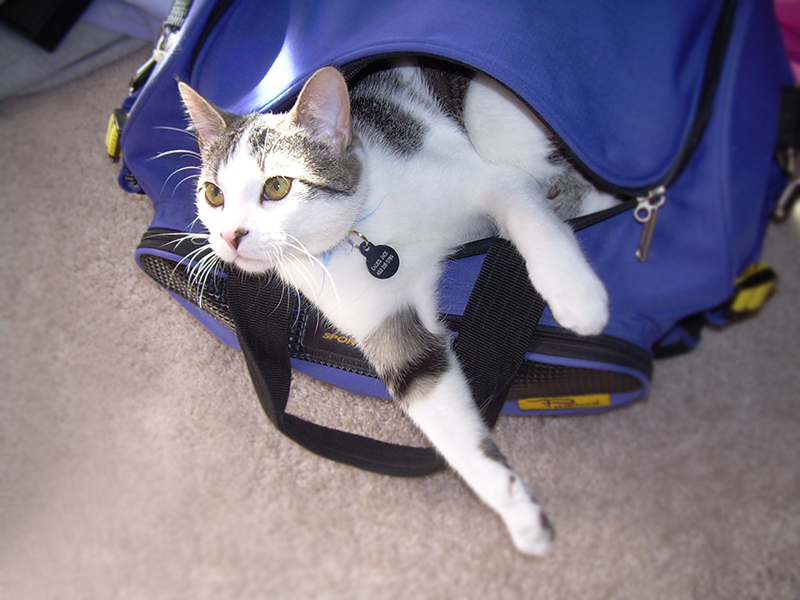Flying with Fido & Fluffy
Nothing is more exciting than an upcoming trip: the culture, the adventures, the food, the naps… But sometimes this excitement is dampened by the impending guilt of leaving your four-legged family member behind. Why not take Fido with you?

Photo by Phillip Cowan / CC BY-ND
There are lots of different ways to travel with your pet; of course, some methods are more comfortable and easier for both of you. Before you hop on the next plane with your furry friend, here are some helpful and important facts to remember to make the process more enjoyable for everyone involved. Separation anxiety? Solved. ✔
Visit the Vet First
Before packing your bags and chew toys, be sure traveling will be a safe and healthy option for your pet. If your pet has an especially nervous disposition and is terribly uncomfortable whenever he or she is in a car, a long flight might not be suitable for him or her. Likewise, if your pet is much older or has existing health conditions or injuries, leaving him or her at home might be the best option. Always consider driving to your destination instead of flying with your pet.
Also, as an extra precaution, make sure that pets who are considered “brachycephalic” and have pushed-in faces like pugs, bulldogs, or Persian cats do NOT travel by plane. They often have respiration limitations to begin with, and the oxygen change at a high altitude can be particularly dangerous for them and leave them prone to heat stroke. Today, many airlines do not allow these breeds to fly in cargo.
If your pet is healthy enough to travel, make sure you’ve researched what kind of health certifications he or she will need for where they’re going and what they’re doing, especially if you’re going across state or country lines. Lastly, make sure your pet’s microchip meets ISO standards so he or she is safely identifiable internationally.
Choosing the Right Flight
When selecting the best flight for you and your pet, be sure to book early. Many airlines limit how many pets are permitted on each flight. Also, make sure both you and your pet are on the same flight, and avoid peak holiday travel days and times if possible. Ideally, check to see whether you can bring your small pet in the cabin of the plane instead of cargo. This will depend on the airline and destination, because they all have different pet restrictions for in-cabin travel.
If you pet must travel in cargo, try to secure a mid-day flight if it’s winter or an early morning or evening flight in the summer so the temperature is more moderate in the cargo hold. Make sure your carrier is very clearly labeled as having a live animal, and include your name, contact info, final destination, and where you can be reached upon arrival.
Finally, make sure your pet’s nails, collar, tags, etc., are all trimmed and secured so there are no moving parts to get stuck in the holes or wires of the crate.

What to Pack
Most importantly, you will need health certifications and an ID for your pet; everything else can be purchased if you forget it. Without these things, your pet may not be able to cross state or country borders. Next, bring the obvious essentials: food (whatever he or she eats at home – nothing new), water, bowls for both, bedding, litter and litter box, a leash, grooming tools, a first aid kit, and his or her favorite and most familiar toys.
Carrier Rules
The type of carrier you’ll need will depend on how you plan to travel. Each airline has its own requirements for approved carriers, and they may also differ based on whether your pet is traveling in the cabin or in cargo. Generally, pet carriers should have a solid, waterproof bottom, plenty of ventilation, secure zippers (locks can be purchased to make them more secure), and be able to contain your pet entirely (no heads or paws hanging out).
Pre-Flight
Don’t give your pet a sedative or tranquilizer unless your veterinarian specifically directs you to. It can interrupt their respiration and cause breathing or heart problems when the altitude causes the cabin or cargo pressure to change. Feed your pet several hours before the flight, and give him or her plenty of water or an ice cube (less messy). Make sure he or she has had plenty of time to play, exercise, and use the grass or litter box before the flight to stay as comfortable as possible.
If the airport is a long distance away from your home, consider spending the night near the airport so your pet isn’t going from a long car ride to a long plane ride. If you do choose to stay in a hotel beforehand, ParkSleepFly has a “Pets Allowed” filter to find the best hotel options for you and your pet!
Traveling with a pet doesn’t have to be stressful. Some simple research and planning will ensure an enjoyable and exciting trip for both of you! Have you traveled with pets before? Post your own tips and experiences in the comments section.
